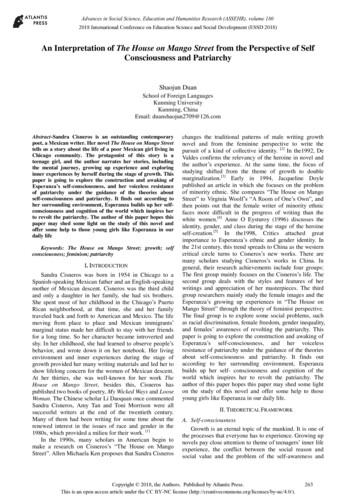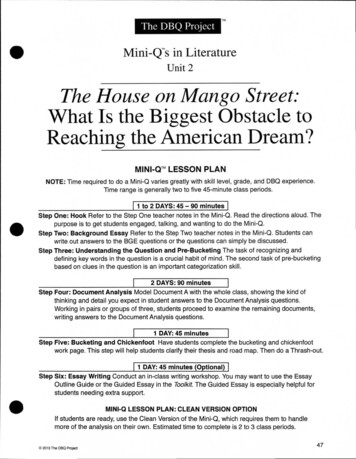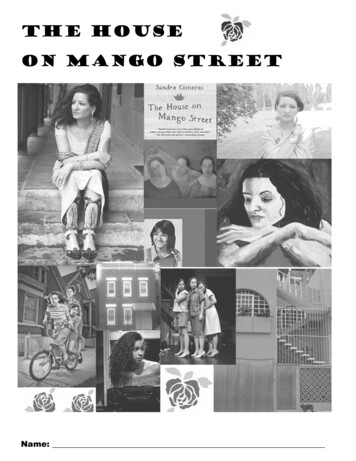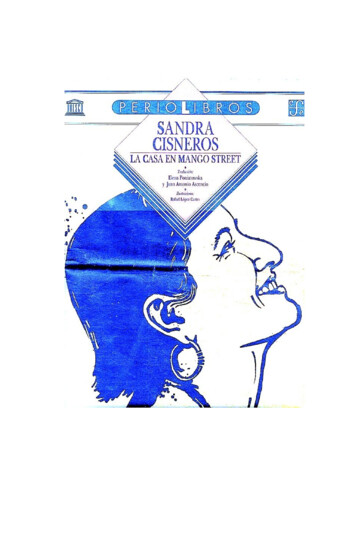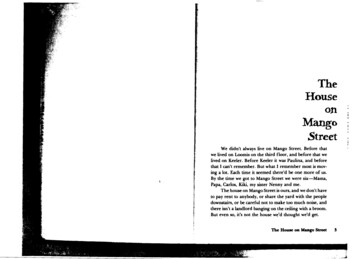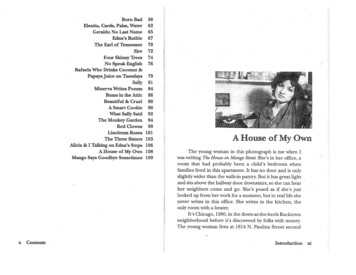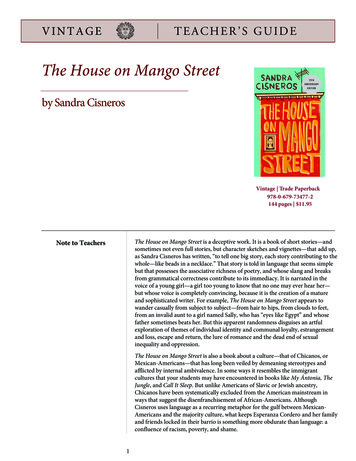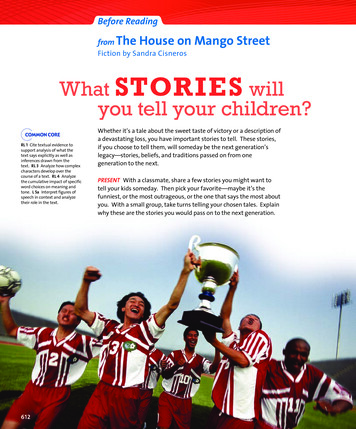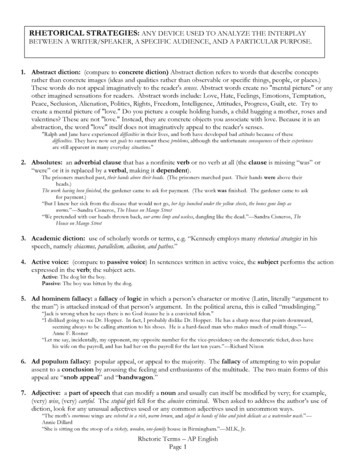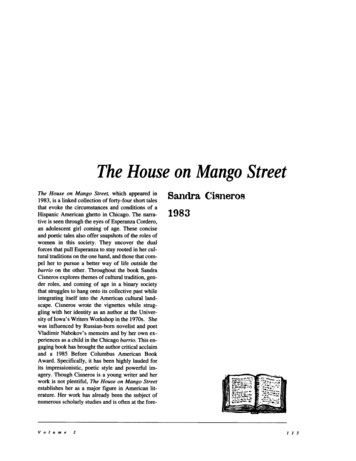
Transcription
The House on Mango StreetThe House on Mango Street, which appeared in1983, is a linked collection of forty-four short talesthat evoke the circumstances and conditions of aHispanic American ghetto in Chicago. The narrative is seen through the eyes of Esperanza Cordero,an adolescent girl coming of age. These conciseand poetic tales also offer snapshots of the roles ofwomen in this society. They uncover the dualforces that pull Esperanza to stay rooted in her cultural traditions on the one hand, and those that compel her to pursue a better way of life outside thebarrio on the other. Throughout the book SandraCisneros explores themes of cultural tradition, gender roles, and coming of age in a binary societythat struggles to hang onto its collective past whileintegrating itself into the American cultural landscape. Cisneros wrote the vignettes while struggling with her identity as an author at the University of Iowa's Writers Workshop in the 1970s. Shewas influenced by Russian-bom novelist and poetVladimir Nabokov's memoirs and by her own experiences as a child in the Chicago barrio. This engaging book has brought the author critical acclaimand a 1985 Before Columbus American BookAward. Specifically, it has been highly lauded forits impressionistic, poetic style and powerful imagery. Though Cisneros is a young writer and herwork is not plentiful, The House on Mango Streetestablishes her as a major figure in American literature. Her work has already been the subject ofnumerous scholarly studies and is often at the fore-V o I u m e2Sandra Cisneros1983I1 3
T h eH o u s eo nM a n g oS t r e e tfront of works that explore the role of Latinas inAmerican society.IFIMIGTIM.The experiences of Esperanza, the adolescentprotagonist of The House on Mango Street, closelyresemble those of Sandra Cisneros's childhood.The author was born to a Mexican father and aMexican American mother in 1954 in Chicago, Illinois, the only daughter of seven children. The family, for whom money was always in short supply,frequently moved between the ghetto neighborhoods of Chicago and the areas of Mexico whereher father's family lived. Cisneros remembers thatas a child she often felt a sense of displacement.By 1966 her parents had saved enough money fora down payment on a run-down, two-story housein a decrepit Puerto Rican neighborhood onChicago's north side. There Cisneros spent muchof her childhood. This house, as well as the colorful group of characters Cisneros observed aroundher in the barrio, served as inspiration for some ofthe stories in The House on Mango Street.The author once remarked, "Because wemoved so much, and always in neighborhoods thatappeared like France after World War 1I-emptylots and burned-out buildings-I retreated insidemyself." Cisneros was an introspective child withfew friends; her mother encouraged her to read andwrite at a young age, and made sure her daughterhad her own library card. The author wrote poemsand stories as a schoolgirl, but the impetus for hercareer as a creative writer came during her collegeyears, when she was introduced to the works ofDonald Justice, James Wright, and other writerswho made Cisneros more aware of her culturalroots.Cisneros graduated from Loyola University in1976 with a B.A. in English. She began to pursuegraduate studies in writing at the University ofIowa, and earned a Master of Fine Arts degree increative writing in 1978. Cisneros says that throughhigh school and college, she did not perceive herself as being different from her fellow English majors. She spoke Spanish only at home with her father, but otherwise wrote and studied within themainstream of American literature. At the University of Iowa Writers' Workshop, Cisneros foundher true voice as an author. Compared with hermore privileged, wealthier classmates from morestable environments, Cisneros's cultural differenceI 1 4Sandra Cisnerosas a Chicana became clear. Though at first she imitated the style and tone of acclaimed American authors, Cisneros came to realize that her experienceas a Hispanic woman differed from that of herclassmates and offered an opportunity to developher own voice. Cisneros once remarked, "Everyone seemed to have some communal knowledgewhich I did not have-My classmates were fromthe best schools in the country. They had been bredas fine hothouse flowers. I was a yellow weedamong the city's cracks." The author began to explore her past experiences, which served as the inspiration of many of her stories and distinguishedher from her peers. Her master's thesis, My WickedWicked Ways (Iowa, 1978, published as a book in1987) is a collection of poems that begins to explore daily experiences, encounters, and observations in this new-found voice.Cisneros has held several fellowships that haveallowed her to focus on her writing full-time. Theseawards have enabled her to travel to Europe and toother parts of the United States, including a stint inAustin, Texas, where she experienced anotherthriving community of Latin American culture. Shehas also taught creative writing and worked withstudents at the Latino Youth Altemative HighSchool in Chicago.N o v e I sf o rS t u d e n t s
T h eThe House on Mango Street is the coming ofage story of Esperanza Cordero, a preadolescentMexican American girl (Chicana) living in the contemporary United States. A marked departure fromthe traditional novel form, The House on MangoStreet is a slim book consisting of forty-four vignettes, or literary sketches, narrated by Esperanzaand ranging in length from two paragraphs to fourpages. In deceptively simple language, the novelrecounts the complex experience of being young,poor, female, and Chicana in America. The novelopens with a description of the Cordero family'shouse on Mango Street, the most recent in a longline of houses they have occupied. Esperanza is dissatisfied with the house, which is small andcramped, and doesn't want to stay there. ButMango Street is her home now, and she sets out totry to understand it.Mango Street is populated by people withmany different life stories, stories of hope and despair. First there is Esperanza's own family: herkind father who works two jobs and is absent mostof the time; her mother, who can speak two languages and sing opera but never finished highschool; her two brothers Carlos and Kiki; and herlittle sister Nenny. Of the neighborhood childrenEsperanza meets, there is Cathy, who shows heraround Mango Street but moves out shortly thereafter because the neighborhood is "getting bad."Then there are Rachel and Lucy, sisters fromTexas, who become Esperanza and Nenny's bestfriends. There is Meme, who has a dog with twonames, one in Spanish and one in English, andLouie the boy from Puerto Rico whose cousinsteals a Cadillac one day and gives all the childrena ride.Then there are the teenage girls of MangoStreet, whom Esperanza studies carefully for cluesabout becoming a woman. There is Marin fromPuerto Rico, who sells Avon cosmetics and takescare of her younger cousins, but is waiting for aboyfriend to change her life. There is Alicia, whomust take care of her father and siblings becauseher mother is dead, but is determined to keep going to college. And there is Esperanza's beautifulfriend Sally, who marries in the eighth grade in order to get away from her father but is now forbidden by her husband to see her friends. Esperanza, Nenny, Lucy, and Rachel discover thatacting sexy is more dangerous than liberating whena neighbor gives them four pairs of hand-me-downV o l u m e2H o u s eo nM a n g oS t r e e thigh heels. They strut around the neighborhoodacting like the older girls until a homeless man accosts them. After fleeing, the girls quickly take offthe shoes with the intention of never wearing themagain.The grown women Esperanza comes across onMango Street are less daring and hopeful than theteenage girls, but they have acquired the wisdomthat comes with experience. They advise Esperanza not to give up her independence in order tobecome a girlfriend or wife. Her Aunt Lupe, whowas once pretty and strong but is now dying, encourages Esperanza to write poetry. Her mother,who was once a good student, a "smart cookie,"regrets having dropped out of school. There areother women in the neighborhood who don't fitinto either category, like Edna's Ruthie, a grownup who "likes to play." While the text implies thatRuthie is developmentally disabled, Esperanzaperceives her as somebody who "sees lovely thingseverywhere."Through observing and interacting with herneighbors, Esperanza forms a connection to MangoStreet which conflicts with her desire to leave. Atthe funeral for Rachel and Lucy's baby sister shemeets their three old aunts who read her palm andher mind:Esperanza. The one with marble hands called measide. Esperanza. She held my face with her blueveined hands and looked and looked at me. A longsilence. When you leave you must remember alwaysto come back, she said.What?When you leave you must remember to come backfor the others. A circle, understand? You will alwaysbe Esperanza. You will always be Mango Street. Youcan't erase what you know. You can't forget who youare.Then I didn't know what to say. It was as if she couldread my mind, as if she knew what I had wished for,and I felt ashamed for having made such a selfishwish.You must remember to come back. For the ones whocannot leave as easily as you. You will remember?She asked as if she was telling me. Yes, yes, I saida little confused.The three sisters tell Esperanza that while shewill go far in life she must remember to come backto Mango Street for the others who do not get asfar. By the novel's end Esperanza has realized thather writing is one way to maintain the connectionto Mango Street without having to give up her ownindependence. She will tell the stories of the "oneswho cannot out."I 1 5
Th eH o u s eo nM a n g oS t r e e tAlicia"Alicia Who Sees Mice" is a young womanburdened by taking care of her family while attending college in order to escape her way of lifein the barrio. She is only afraid of mice, whichserve as a metaphor for her poverty.CathyCathy, "Queen of Cats," as Esperanza calls herbecause of her motley collection of felines, is oneof Esperanza's neighborhood playmates. Cathytells Esperanza that she and her family are leavingbecause the neighborhood into which Esperanzahas just moved is going downhill.Carlos CorderoCarlos is Esperanza's younger brother. Thebrothers have little interaction with Esperanza andNenny outside of the structure of the household.Esperanza Cordero"In English my name means hope. In Spanishit means too many letters," says Esperanza Cordero.In a child-like voice, Esperanza records impressionsof the world around her. Her perceptions range fromhumorous anecdotes pulled from life in the barrioto more dark references to crime and sexual provocation. Through Esperanza's eyes, the readercatches short yet vivid glimpses of the other characters, particularly the females in Esperanza'sneighborhood. In part, Esperanza finds her sense ofself-identity among these women. With a sense ofawe and mystery, for example, she looks to oldergirls who wear black clothes and makeup. She experiments with womanhood herself in "The Familyof Little Feet," a story in which Esperanza and herfriends cavort about the neighborhood in high heelshoes, but are forced to flee when they attract unwanted male attention. Esperanza's sense of selfidentity is also interwoven with her family's house,which emerges throughout the book as an important metaphor for her circumstances. She longs forher own house, which serves as a symbol of the stability, financial means, and sense of belonging thatshe lacks in her environment: "a house all myown-Only a house quiet as snow, a space for myself to go, clean as paper before the poem."As the stories develop, Esperanza matures. Shetums from looking outward at her world to a moreintrospective viewpoint that reveals several sides ofher character. Esperanza is a courageous girl whorecognizes the existence of a bigger world beyondI 1 6her constraining neighborhood, and who, toward theend of the book, is compelled by her own innerstrength to leave the barrio. Nonetheless, Esperanzademonstrates empathy for those around her, particularly those who do not see beyond the confines oftheir situations: "One day I will say goodbye toMango. I am too strong for her to keep me here forever. One day I will go away. Friends and neighbors will say, What happened to that Esperanza?Where did she go with all these books and paper?Why did she march so far away? They will not knowI have gone away to come back. For the ones I leftbehind. For the ones who cannot out." In "Bums inthe Attic," Esperanza says, "One day I'll own myown house, but I won't forget who or where I camefrom." The tension between Esperanza's emotionalties to this community and her desire to transcendit establish a sense of attraction and repulsion thatcharacterize the work.Kiki CorderoKiki, "with hair like fur," is Esperanza'syounger brother.Magdalena Cordero"Nenny" is Esperanza's younger sister. Esperanza sees her little sister as childish and unable tounderstand the world as she does: "Nenny is tooyoung to be my friend. She's just my sister and thatwas not my fault. You don't pick your sisters, youjust get them and sometimes they come likeNenny." However, because the two girls havebrothers, Esperanza understands that Nenny is herown responsibility to guide and protect. Esperanzaand Nenny share common bonds both as sisters andas Chicana females. In the story "Laughter," a certain neighborhood house reminds both sisters ofMexico, a connection possible only because of theirshared experience: "Nenny says: Yes, that's Mexico all right. That's what I was thinking exactly."Mama CorderoEsperanza's mother is typical of the women inLatin American communities whose life is definedby marriage, family, children, and traditionally female activities. Mama reveals herself as a superstitious figure who tells Esperanza that she wasbom on an evil day and that she will pray for her.Mama operates as a caretaker and has authorityover her household, and she is portrayed as a martyr, sacrificing her own needs for those of her family. "I could've been somebody, you know?" Mamaproclaims to Esperanza, explaining that she leftschool because she was ashamed that she didn'tN o ve I sf o rS t u d e n t s
T h ehave nice clothes. Mama wishes for her daughtersa better life outside the cycle of subjugation thatcharacterizes her own, and she views education asthe ticket out of that way of life.Nenny CorderoSee Magdalena CorderoPapa CorderoEsperanza's father is portrayed as a man burdened with the obligation of providing for his family. Papa holds up a lottery ticket hopefully as hedescribes to the family the house they will buy oneday. In the story "Papa Who Wakes Up Tired in theDark," Papa reveals his vulnerability to Esperanza,his eldest child, when he learns of his own father'sdeath and asks her to convey the news to her siblings while he returns to Mexico for the funeral.EarlThis man with a southern accent, a jukebox repairman according to Esperanza, appears in thestory "The Earl of Tennessee." He occupies a darkbasement apartment and brings home women of illrepute whom Esperanza and her friends naivelytake to be his wife.ElenitaElenita, "witch woman" who tells fortuneswith the help of Christian icons, tarot cards, andother accouterments, tells Esperanza after readingher cards that she sees a "home in the heart. Thisleaves Esperanza disappointed that a "real house"does not appear in her future.o nM a n g oS t r e e tMediaAdaptationsThe House on Mango Street was adapted as asound recording entitled House on MangoStreet; Woman Hollering Creek, published byRandom House in 1992. It is read by Sandra Cisneros.tragic figure who stays indoors all the time becauseof her fear of speaking English.MarinMarin is a Puerto Rican neighbor, an older girlwith whom Esperanza and her friends are fascinated. Marin wears makeup, sells Avon, and has aboyfriend in Puerto Rico whom she secretly intendsto marry, but meanwhile, she is responsible for thecare of her younger cousins.MinervaMinerva is a young woman not much olderthan Esperanza who "already has two kids and ahusband who left."Juan OrtizLouieThe oldest in a family of girls, Louie and hisfamily rent a basement apartment from Meme Ortiz's mother. His cousin Marin lives with the family and helps take care of his younger sisters. Although Louie is really her brother's friend,Esperanza notices that he "has two cousins and thathis t-shirts never stay tucked in his pants."LucyLucy is a neighborhood girl whom Esperanzabefriends even though her clothes "are crooked andold." Lucy and her sister Rachel are among the firstfriends Esperanza makes when she moves ontoMango Street.MamacitaIn "No Speak English," Mamacita is the plumpmother of a man across the street, a comic andV o I u m eH o u s e2"Meme" is a neighbor of Esperanza's who hasa large sheepdog. "The dog is big, like a mandressed in a dog suit, and runs the same way itsowner does, clumsy and wild and with the limbsflopping all over the place like untied shoes."Meme OrtizSee Juan OrtizRachelRachel is Lucy's sister, a sassy girl accordingto Esperanza. Esperanza and Lucy parade aroundthe neighborhood in high heel shoes with her in thestory "The Family of Little Feet."RafaelaRafaela stays indoors and observes the worldfrom her windowsill, "because her husband isafraid Rafaela will run away since she is too beauI 1 7
T h eH o u s eo nM a n g oS t r e e ttiful to look at." Rafaela stands as a symbol for theinterior world of women on Mango Street, whoselives are circumscribed and bound by the structureof home and family.RuthieRuthie, "the only grown-up we know who likesto play," is a troubled, childlike woman whose husband left her and was forced to move from her ownhouse in the suburbs back to Mango Street with hermother.SallySally wears black clothes, short skirts, nylons,and makeup. Esperanza looks upon her with fascination and wonder, and wants to emulate her, butthe dark side of Sally's life is revealed in her relationship with her abusive father. She trades onetype of ensnarement for another by manrying amarshmallow salesman before the eighth grade.SireSire is a young man who leers at Esperanza asshe walks down the street, provoking in her inextricable feelings of desire, foreboding, and fear. Esperanza says that "it made your blood freeze to havesomebody look at you like that."The Three Sisters"The Three Sisters" are Rachel and Lucy's elderly aunts who come to visit when Rachel andLucy's baby sister dies. The three ladies recognizeEsperanza's strong-willed nature, and plead withher not to forget the ones she leaves behind onMango Street when she flees from there one day.Rosa VargasIn the story, "There Was an Old Woman SheHad So Many Children She Didn't Know What toDo," Rosa is portrayed as a woman left in the lurchby a husband who abandoned her and their unrulykids. "They are bad those Vargas, and how can theyhelp it with only one mother who is tired all thetime from buttoning and bottling and babying, andwho cries every day for the man who left withouteven leaving a dollar for bologna or a note explaining how come."Coming of AgeThrough various themes in The House onMango Street Esperanza reveals herself as both aI 1 8product of the community in which she lives andone of the only figures courageous enough to transcend her circumstances. Like all adolescents, Esperanza struggles to forge her own identity. Inmany respects, Esperanza's own keen observationsand musings about the women in her neighborhoodare her way of processing what will happen to herin the future and what is within her power tochange. On the one hand, she is surrounded by adolescent myths and superstitions about sexuality. Inthe story "Hips," the adolescent Esperanza contemplates why women have hips: "The bones justone day open. One day you might decide to havekids, and then where are you going to put them?"Esperanza boldly experiments with the trappingsof womanhood by wearing high heels in "TheFamily of Little Feet," and in "Sally," she looksenviously to the girl as an image of maturity: "Mymother says to wear black so young is dangerous,but I want to buy shoes just like yours." However,Esperanza's brushes with sexuality are dangerousand negative in "The First Job" and "Red Clowns,"and she feels betrayed by the way love is portrayedby her friends, the movies, and magazines. Esperanza observes characters such as Sally, Minerva,and Rafaela, who, through early and abusive marriages, are trapped in the neighborhood and intoidentifying themselves through their male connections. After witnessing this, Esperanza says in"Beautiful & Cruel," "I have decided not to growup tame like the others who lay their necks on thethreshold waiting for the ball and chain." Esperanza also forges her identity through the metaphorof the house. Her longing for a house of her ownunderscores her need for something uplifting andstable with which she can identify. Throughout thebook there is a tension between Esperanza's tiesto the barrio and her impressions of another kindof life outside of it. Ultimately, Esperanza's ability to see beyond her immediate surroundings allows her to transcend her circumstances and immaturity.Culture and HeritageDifferenceEsperanza keenly observes the struggles ofHispanic Americans who wish to preserve theessence of their heritage while striving to forge productive lives within American culture. It is throughthe sordid details of the lives of Esperanza's neighbors that we glimpse the humorous, moving, andtragic sides of these struggles. Esperanza's community serves as a microcosm of Latinos in America, and her own identity is interwoven with theN o v e I sf o rS t u d e n t s
T h eidentity of the neighborhood. People in the barriorelate to one another because of a shared past andcurrent experience. In "Those Who Don't," Esperanza considers the stereotypes and fears that whiteshave of Latinos and vice versa. Cisneros weavestogether popular beliefs, traditions, and other vestiges of the countries from which she and herneighbors trace their ancestry. In "No Speak English," for example, an old woman paints her wallspink to recall the colorful appearance of the housesin Mexico, a seemingly hopeless gesture in the drabunderbelly of Chicago. She wails when her grandson sings the lyrics to an American television commercial but cannot speak Spanish. The tragic Mamacita risks losing her identity if she assimilates,like her little grandson, into American culture. In"Elenita, Cards, Palm, Water," the so-called "witchwoman" of the neighborhood preserves the oldwives' tales, superstitions, and traditional remediesfor curing headaches, forgetting an old flame, andcuring insomnia.Despite these ties to the past, Esperanza leavesno doubt that she is destined to leave this neighborhood for a bigger world outside the barrio, anallusion to her dual cultural loyalties. Esperanza believes that one day she will own her own house outside the neighborhood. However, she also leavesno doubt that she will return one day for those unable to leave the environment on their own. In"Bums in the Attic," for example, she describeshow she will let bums sleep in the attic of her houseone day, "because I know how it is to be withouta house." In "The Three Sisters," Esperanza givesfurther foreshadowing that she will one day leaveMango Street, but will return to help others. "Youwill always be Mango Street," three ladies tell her."You can't erase what you know. You can't forgetwho you are." Esperanza leaves the reader with thenotion that she will leave but will not forget herroots. Though she does not always want to belongto this environment, she realizes that her roots aretoo strong to resist. The books and papers Esperanza takes with her at the end of the book are hermeans of freedom from the ugly house and the social constraints on the neighborhood.Gender RolesThe House on Mango Street is dedicated "a lasMujeres"-to the women. As the narrator, Esperanza offers the reader the greatest insights into thelives of female characters. One of the most enduring themes of the book is the socialization of females within Chicano society based on the fixedroles of the family. Cisneros explores the dynamV o I u m e2H o u s eo nM a n g oS t r e e tTopics forFurtherStudy**Characterize the social constraints of the womenin Esperanza' s neighborhood, and describe howEsperanza both responds to and transcends thesocial forces in her environment.Discuss the metaphor of the house in The HouseMango Street.Discuss The House on Mango Street in relationship to the history of Mexican Americans inlarge cities of the United States.on*ics of women's lives within this precarious andmale-dominated society, where the conditions offemales are predetermined by economic and socialconstraints. For most women in the neighborhood,these constraints are too powerful to overcome.However, Esperanza possesses the power to see beyond her circumstances and the world of the ghetto,while those around her fall prey to it and perpetuate its cycle. Esperanza's mother is typical of a Hispanic woman grounded in this way of life.Throughout the book, Esperanza deals withthemes of womanhood, especially the role of singlemothers. The interior world of females whose livesare tied to activities inside the house is contrastedwith the extemal world of males, who go to workand operate in society at large. In "Boys & Girls,"for example, Esperanza notes the difference betweenherself and her brothers: "The boys and the girls livein separate worlds. The boys in their universe andwe in ours. My brothers for example. They've gotplenty to say to me and Nenny inside the house. Butoutside they can't be seen talking to girls."Esperanza offers a feminine view of growingup in a Chicano neighborhood in the face of a socialization process that keeps women married, athome, and immobile within the society. Thewomen in this book face domineering fathers andhusbands, and raise children, often as single parents, under difficult circumstances. Many taleshave tragic sides, such as those that paint the constrained existence of some of the women and girlsin the neighborhood under the strong arm of husI l 9
Th eH o u s eo nM a n g oS t r e e tbands or fathers. The story "There Was an OldWoman She Had So Many Children She Didn'tKnow What to Do," tells of an abandoned youngwife and her unruly children. In "Linoleum Roses,"Sally is not allowed to talk on the phone or lookout the window because of a jealous, domineeringhusband. Girls marry young in this society: "Minerva is only a little bit older than me but alreadyshe has two kids and a husband who left." But Esperanza is a courageous character who defies thestereotypes of Chicanas. She laments the attitudesthat prevail in her community. Of her name, Esperanza says, "It was my great-grandmother'sname and now it is mine. She was a horse womantoo, born like me in the Chinese year of the horsewhich is supposed to be bad luck if you're born female-but I think this is a Chinese lie because theChinese, like the Mexicans, don't like their womenstrong." It is Esperanza's power to see beyond thebarriers of her neighborhood, fueled by her education gained through reading and writing, that keepher from being trapped in the same roles as thewomen who surround her.Point of ViewThe House on Mango Street is narrated by theadolescent Esperanza, who tells her story in theform of short, vivid tales. The stories are narratedin the first person ("I"), giving the reader an intimate glimpse of the girl's outlook on the world. Although critics often describe Esperanza as a childlike narrator, Cisneros said in a 1992 interview inInterviews with Writers of the Post-Colonial World:"If you take Mango Street and translate it, it's Spanish. The syntax, the sensibility, the diminutives, theway of looking at inanimate objects-that's not achild's voice as is sometimes said. That's Spanish!I didn't notice that when I was writing it." Incorporating and translating Spanish expressions literally into English, often without quotation marks,adds a singular narrative flavor that distinguishesCisneros's work from that of her peers.SettingThe House on Mango Street is set in a Latinoneighborhood in Chicago. Esperanza briefly describes some of the rickety houses in her neighborhood, beginning with her own, which she says is"small and red with tight steps in front." Of MemeOrtiz's house, Esperanza says that "Inside the floorsslant-And there are no closets. Out front there are1 2 0twenty-one steps, all lopsided and jutting likecrooked teeth." Mamacita's son paints the insidewalls of her house pink, a reminder of the Mexicanhome she left to come to America. The furniture inElena's house is covered in red fur and plastic. Esperanza gives the impression of a crowded neighborhood where people live in close quarters and leanout of windows, and where one can hear fighting,talking, and music coming from other houses on thestreet. Esperanza describes the types of shops in theconcrete landscape of Mango Street: a laundromat,a junk store, the corner grocery. Cats, dogs, mice,and cockroaches make appearances at various times.However, while Esperanza gives fleeting glimpsesof specific places, the images that the girl paints ofher neighborhood are mostly understood throughthe people that inhabit it.StructureJust like Esperanza, whose identity isn't easyto define, critics have had difficulty classifying TheHouse on Mango Street. Is it a collection of shortstories? A novel? Essays? Autobiography? Poetry?Prose poems? The book is composed of very short,loosely organized vignettes. Each stands as a wholein and of itself, but collectively the stories cumulate in a mounting progression that creates an underlying coherence; the setting remains constant,and
The House on Mango Street is the coming of age story of Esperanza Cordero, a preadolescent Mexican American girl (Chicana) living in the con-temporary United States. A marked departure from the traditional novel form, The House on Mango Street is a slim book consisting of forty-four vi-gnettes, or literary sketches, narrated by Esperanza

